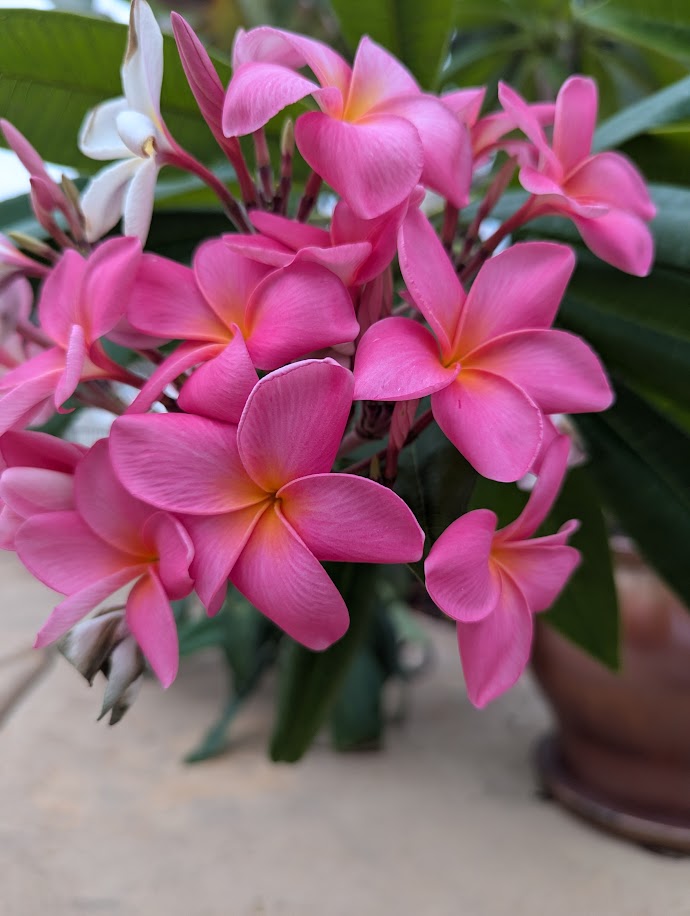Why are my Plumeria leaves turning yellow and dropping?

Plumerias – photo: Sharon Zornes
Answer: No need for alarm - a temporary leaf drop during November or December is normal.
Growing Plumeria Beauties in San Diego
By Sharon Zornes
Plumeria is a tropical genus of 11 species of small trees or shrubs, also known by the name frangipani. They thrive in hot, tropical climates with high humidity. In many regions outside the tropics, including San Diego, plumerias go dormant in the winter. During this time, the plant may shed its leaves as it conserves energy and resources. This is a natural part of their growth cycle. As temperatures drop significantly in December, the cold can also trigger leaf drop. Plumerias are sensitive to cold and shed leaves to protect themselves from potential frost damage.
Shorter daylight hours in winter can affect the plant's growth cycle, also contributing to leaf drop. Plumerias need a lot of light to thrive, and reduced light can signal the plant to slow down and drop leaves. If you’ve altered your watering schedule in response to cooler weather, this might also affect the plant. Plumerias generally need little to no water during the winter months, so ensure you're not overwatering.
San Diego's mild, Mediterranean climate makes it an ideal locale for plumerias, allowing these tropical beauties to thrive nearly year-round. However, to keep them looking their best and blooming beautifully, it's essential to tailor their care to the changing seasons and your bioclimate.
As spring temperatures warm up, plumerias come out of their winter dormancy. This is the perfect time to start feeding them with a high-phosphorus fertilizer (the middle number in your fertilizer description) to boost growth and flower production. Begin watering more frequently, ensuring the soil is well-drained to prevent root rot. Prune any dead or damaged branches to encourage healthy new growth and shape the plant.
Summer is the peak growing season for plumerias. They flourish under the San Diego sun, so ensure they receive full sunlight for at least six hours a day. Keep up with regular watering, especially during hotter spells, but avoid waterlogging by allowing the soil to dry out between sessions. If you live in the warmer inland valleys and east county, you will want to mist them on hot days and provide shade for them during the heat of the day. If living in the coastal areas, the humidity will be perfect for them to thrive. Summer is also a good time to apply a balanced fertilizer (all three fertilizer numbers will be the same) every few weeks to support robust blooming.
As temperatures start to cool in the fall, reduce watering frequency, but continue to provide occasional deep watering. This is also a good time to start preparing your plumerias for winter by cutting back on fertilizers. Clean up fallen leaves and spent flowers to prevent fungal issues.
Plumerias are dormant during the cooler months of winter. A good rule of thumb is to stop watering between Thanksgiving and St. Patrick’s Day. When necessary, protect them from frost by covering with frost cloths if temperatures drop into the 30’s. Stop watering and avoid fertilizing until spring. If growing in pots, consider moving them to a sheltered spot.
With these seasonal adjustments, your plumerias will continue to dazzle with their vibrant blooms, adding a touch of tropical charm to your San Diego landscape. Imagine strolling through your garden and being greeted by the intoxicating fragrance of plumerias, their blooms echoing the vibrant hues of a tropical sunset.Top of Form
To find more information on growing these beauties in San Diego County, visit the following websites:
https://southerncaliforniaplumeriasociety.com/
https://hort.extension.wisc.edu/articles/plumeria/

